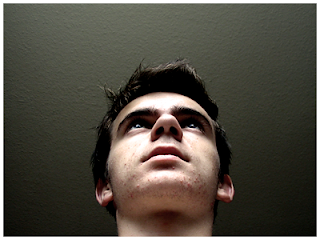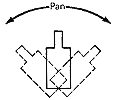Camera Angles :
The relationship between the camera and the object being photographed (i.e the ANGLE) gives emotional information to an audience, and guides their judgement about the character or object in shot.
The following are some of the basic angles used in Film:
1.Normal or Eye Angle :
In a normal angle shot the camera is positioned at approximately the subject's eye level, shooting the scene as we would normally view the world.
In other word's a fairly neutral shot, the camera is positioned as though it is a human actually observing a scene.
The camera will be placed approximately five to six feet from the ground.Remember, the normal angle refers to the subject's position, not the position most comfortable for you.
The following image shows how Normal or Eye angle is

The camera will be placed approximately five to six feet from the ground.Remember, the normal angle refers to the subject's position, not the position most comfortable for you.
The following image shows how Normal or Eye angle is

2.High Angle:
In a high angle shot the camera is positioned above eye level, with the camera shooting down on the subject. A high camera angle is useful for showing the audience an overview of your scene or shooting area. High angles make the object photographed seem smaller, and less significant.The following image shows how High Angle is

3.Low Angle:
In a low angle shot the camera is positioned below eye level, with the camera shooting up at the subject. Shooting up from a low angle makes the subject appear larger and suggests a feeling of power and dominance.The camera will be placed approximately five to six feet from the ground.The following image shows how Low Angle is

4.Canted Angle:
In a canted angle the camera is tilted(i.e is not placed horizontal to floor level), to suggest imbalance, transition and instability.This suggests a feeling of excitement, suspense or fantasy to the viewer.The following image shows how Canted Angle is

5.Subjective Angle:
In a subjective angle the camera is put in place of a character and shows us the scene from the character's point of view. Subjective angles are useful for bringing the viewer into the action. When used effectively a subjective camera angle can make a great impact on the viewer.
The following image shows how Subjective Angle is
Camera Movements:
A director may choose to move action along by telling the story as a series of cuts, going from one shot to another, or they may decide to move the camera with the action. Moving the camera often takes a great deal of time, and makes the action seem slower, as it takes several second for a moving camera shot to be effective, when the same information may be placed on screen in a series of fast cuts. Not only must the style of movement be chosen, but the method of actually moving the camera must be selected too. The following are the basic camera moves:
1.Pan:
A movement which scans
a scene horizontally.Moving the camera
lens to one side or another. Look to your left, then look to your right -
that's panning.Most pans should be
executed smoothly and slowly. Most beginners make the mistake of panning too
frequently and too fast, leaving their audience disoriented. One exception
is a special kind of pan called the swish pan or whip pan. This is a rapid move that looks like a swish on the screen. It is sometimes used for transitions or for
other special effects.

2.Tilt:
A
tilt is the vertical movement of the camera on a stationary pedestal or tripod.
The command is usually "Tilt up" or "Tilt down", and
is used to establish vertical subjects or to follow vertical movement.
The following image shows how Tilt moments takes place
3.Dolly:
The following image shows how Dolly moments takes place
4.Truck:
Trucking is like dollying, but it involves motion left or
right. The command is usually "Truck left" or
"Truck right". Truck left
means "move the camera physically to the left”,where as Truck right means
“move the camera physically to the right”.
The following image shows
how Truck moments takes place
5.Hand-held:
Sometimes the action is moving too quickly or too unpredictably for the
camera to be on a tripod. This calls for making the camera more mobile and able
to follow the action of a scene. Most times the camera will simply be held by
the operator, who will then employ a number of basic camera moves by moving the
feet - trucking in and out, dollying in one direction or another, tilting,
panning, zooming - and combinations of all of these.
6.Crane/Jib:
A crane can be used to lift a camera (and operator, if it's
big enough) from low to high shooting positions. It is a large, heavy piece of equipment, but is
a useful way of moving a camera - it can move up, down, left, right, swooping
in on action or moving diagonally out of it. The camera operator and camera are
counter-balanced by a heavy weight, and trust their safety to a skilled
crane/jib operator .
7.Pedestal:
Moving the camera up or down without changing its vertical or
horizontal axis. A camera operator can do two types of pedestals: pedestal up
means "move the camera up;" pedestal down means "move the camera
down." You are not tilting the lens up, rather you are moving the entire
camera up. Imagine your camera is on a tripod and you're raising or lowering
the tripod head (this is exactly where the term comes from).
8.The Aerial shot:
An exciting variation of a crane shot,
usually taken from a helicopter. This is often used at the beginning of a film,
in order to establish setting and movement.
9.Zoom:
Zooming is one camera
move that most people are probably familiar with. It involves changing the
focal length of the lens to make the subject appear closer or further away in
the frame. Most video cameras today have built-in zoom features. Some have
manual zooms as well, and many have several zoom speeds. Zooming is one of the
most frequently-used camera moves and one of the most overused. Use it
carefully.










